Contractor finds success in simple, scalable hydronic designs
The upside of down economies: forging an ironclad business.

Photos courtesy of Dan Vastyan / Common Ground.
Like many immigrants who landed in the United States in the 1960s, Jim Harper Sr. brought a trans-Atlantic work ethic with him from Ireland, ultimately passing that discipline on to his son.
“I was born in Boston and attended the Tri-County Regional Vocational Technical High School in Franklin, Massachusetts, where I studied under master plumbers John Blaney and Joseph Conley,” says Jim Harper Jr. “For that, I’m forever grateful.”
In the early 1990s, the economy on the East Coast slowed to a crawl, but there was work in Colorado for those willing to make the move. Harper took a job with Caribou Plumbing in Nederland, Colorado, and put his hydronic experience to work first on tract homes and later, on big custom houses. This sparked Harper’s interest in commercial-scale residential hydronics.

Brandon Content and Brandon Pease set up the new tekmar Smart Boiler Control 294.

The multi-boiler system at PSI’s new shop offers remote monitoring and access through the use of a tekmar Smart Boiler Control 294.
A few short months after founding his own company, Plumbing Systems Inc. (PSI), Harper was forced to put it on ice. Sept. 11, 2001, halted the residential boom in the mountains of Colorado. For the second time in his career, Harper looked out of state for work.
“The fallout of the first economic crunch I dealt with in Boston served me in 2001,” Harper says. “I knew many tradespeople that left Boston in the early 1990s. One of those friends had gone to Texas, and there was still work there after 9/11. So I packed my bags for San Antonio.”
Until that time, Harper had only worked in new construction. His friend’s company in Texas was strictly service, and Harper spent two years learning that side of the business.
“I found that I loved service work but I didn’t care for San Antonio,” Harper says. “Too hot and no mountains.”
In May of 2003, Harper moved to Vail Valley, Colorado and restarted Plumbing Systems Inc. It was during this time that he met his wife, Mary. Shortly after, their daughter Ava was born. Life in the Vail Valley got exciting fast.
PSI grows
Today, PSI has 70 employees, with one division in Vail and another in Silverthorne. Early on, PSI completed a few new home projects but quickly focused on service and retrofit. Growth was slow but steady. It picked up in 2014 when Harper hired a business consultant, Al Levy, of The 7-Power Contractor.
In addition to residential service work, PSI operates five commercial jetter trucks, either U.S. Jetting or Spartan Tool units.
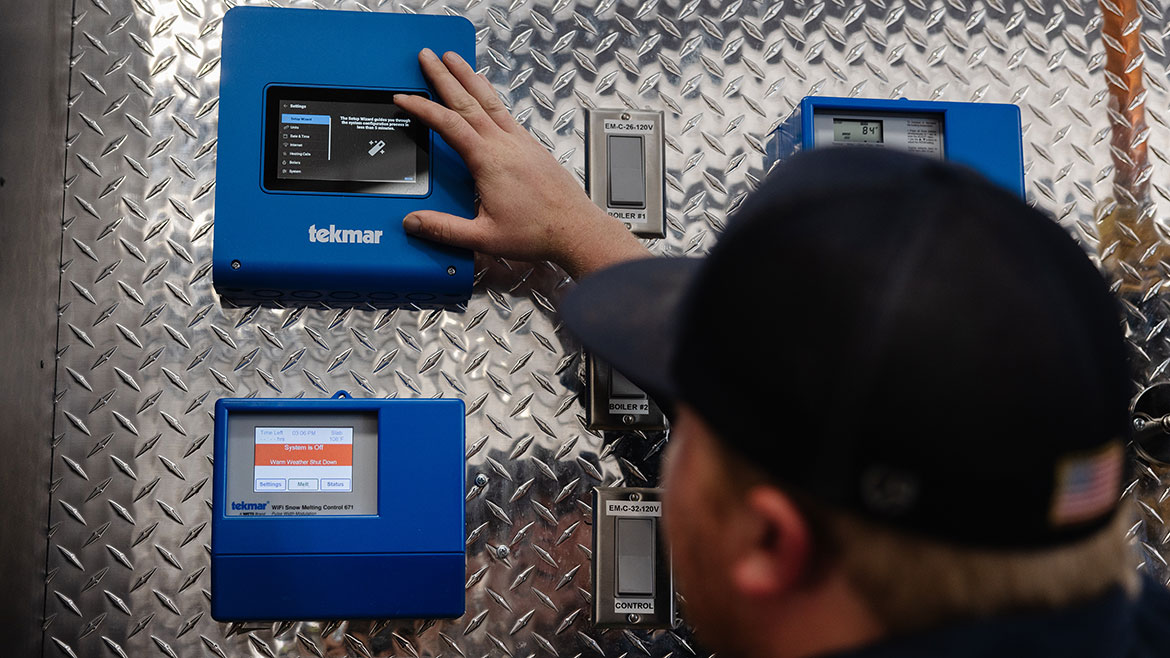
A PSI technician establishes a web connection on the tekmar Smart Boiler Control 294.
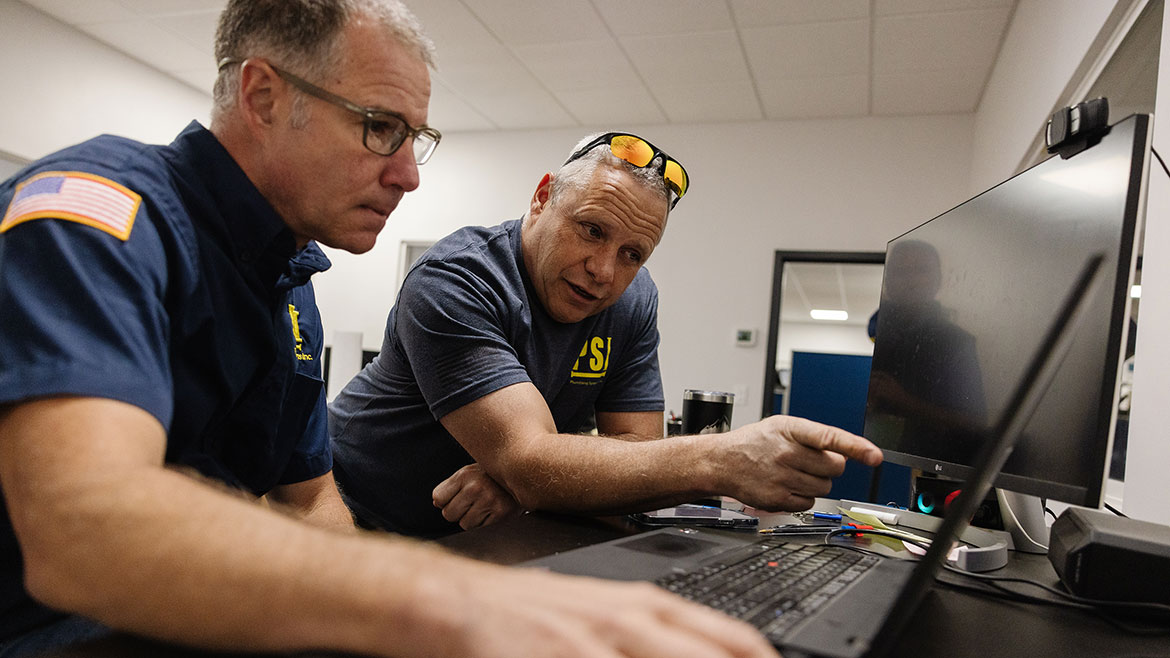
(L-R) Peter Geyer, PSI head of special products, discusses a new CRM program with PSI founder Jim Harper.
There are a lot of hotels in the area, so PSI does plenty of drain rehabilitation projects: UV lining, pipe patch repairs, spray lining, open-cut excavation, etc. On the residential side, the average home PSI serves is $3 to $4 million, though more than a few exceed $20 million.
“Vail Valley may have the highest concentration of high-end hydronic systems anywhere on the planet,” Harper says. “Park City, Utah is certainly up there, too, but I think Vail might take the cake. There aren’t too many places you’ll find four-inch gas lines on single-family residential projects.”
The local atmosphere demands robust heating systems that offer premium comfort; high elevation, high snowfall, long winters and many vacation homes. After two decades of conducting high-end boiler retrofits, PSI has standardized its hydronic approach. No detail is overlooked, no wire is out of place and no expense is spared.
Ski in, ski out
Hugging a ski run and surrounded by aspen trees is an 11,000-square-foot modern chalet-style home where PSI recently finished a boiler replacement job. Ironically, it’s one of very few new construction projects that Harper took on in 2003. In May of 2023, Brandon Content, PSI outside salesman and system designer, visited the recently sold home to bid the project.
“This was PSI’s first boiler room, so returning 20 years later was pretty special,” says Content, who’s been with the company for seven years. “The new owner wanted to upgrade the three cast-iron boilers and modernize the whole room.”
The system included in-floor, hydro-air, DHW production and 6,000 square feet of snow-melt under two patios and the entire driveway. In addition to all high-efficiency components, the owner wanted remote access and monitoring for the boiler system.

One of four mechanical rooms on the property, PSI’s hydronic design serves 45 heating zones, pool heating, a heated stream and lots of snow-melt.

Brandon Content, PSI outside sales and system designer, changes control parameters on a tekmar system.
“I was told to design the system as though it was my own house with no concern for cost,” Content says. “Meanwhile, the owner collected two other bids, one from his handyman and one from a competitor of ours who wanted to replace the boilers without updating the rest of the system.”
The owner informed Content that the PSI bid was three times more than the competitor’s and asked why. Content walked him through the bid line item by line item, explaining why each component was chosen. After that, PSI’s bid was accepted.
PSI’s approach
“I was a lead service technician for PSI before I took my current position,” Content says. “There was a landmark moment in my career when I grew tired of fixing old equipment and band-aiding systems. That’s when I dove into learning as much as I could about sales and began selling modern, cutting-edge systems. I wanted our boiler systems to be immediately recognizable. I want homeowners to show off their systems like they’d show off a new Ferrari.”
Like all his boiler room layouts, Content designed the home’s system to be robust, clean and elegantly simple. The new system includes three, 399 MBH IBC condensing boilers, two 80-gallon Lochinvar sidearm tanks for DHW, a tekmar control system and variable-speed, ECM circulators.
“There are five Taco 0034ePlus circulators: one for each boiler, one for the 15-zone radiant system, which is set to pressure differential control, and one for the patio snowmelt,” Content explains. “We use the 00e series a lot because it has a variety of control options, so it’s very flexible. The driveway snow-melt system is served by a Taco VR Series pump because we needed more capacity.
“I like to zone my systems with valves instead of circulators,” he continues. “It keeps the upfront cost down, requires fewer flanges, and reduces electric consumption. I also think it creates a cleaner-looking room, especially when you have this many zones.”
The owner impressed upon Content that the home would rarely be occupied, and he was worried about the property freezing in the event of a system failure.
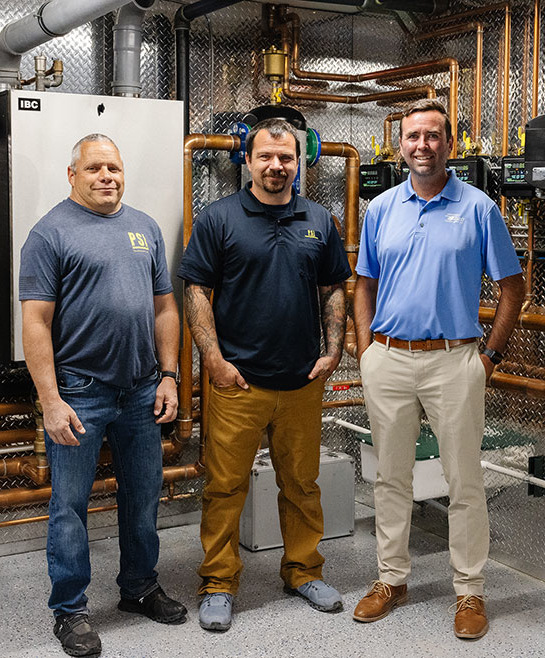
From Left to Right: Jim Harper, Brandon Content, and Shamrock Sales’ Brandon Pease.
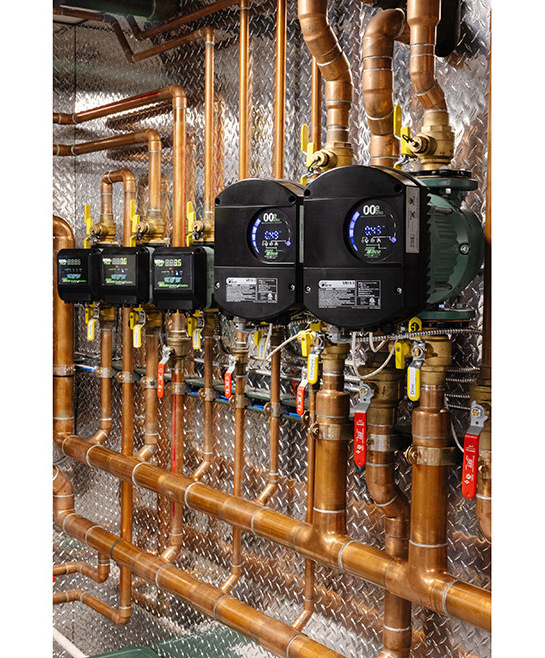
Brandon Content installs Taco 00e Series circulators for large snow-melt applications.
“The snow-melt systems and the home are filled with Fernox Alphi 11 antifreeze,” Content says. “We used a 30% mixture inside and a 50% mixture outside. For remote system access and monitoring, we installed the new tekmar Smart Boiler Control 294, which was introduced to us by Brandon Pease at Shamrock Sales.”
“Almost everything in our mechanical rooms is on Shamrock Sales’ line card,” Harper says. “They’re among the very best rep firms in the country. They keep us apprised of new Taco pump technology and controls. When they introduced us to the tekmar Smart Boiler Control 294, we realized it offered a solution we’ve been needing for some time. Not only does it provide remote access to the boiler system, but we can stage multiple different boilers, regardless of the makes, models and ages of those boilers.”
Commercial scale
The beauty of PSI’s hydronic designs is that they’re scalable. The same approach and the same components can be applied to small time-share condos or mountaintop starter castles.
At 18,000 square feet, not including the immaculate caretaker’s house, a different home — this one for an existing service customer — needed new boilers. The main residence included 45 heating zones, 15,000 square feet of snow-melt, a large pool and a man-made stream that’s heated throughout the winter.
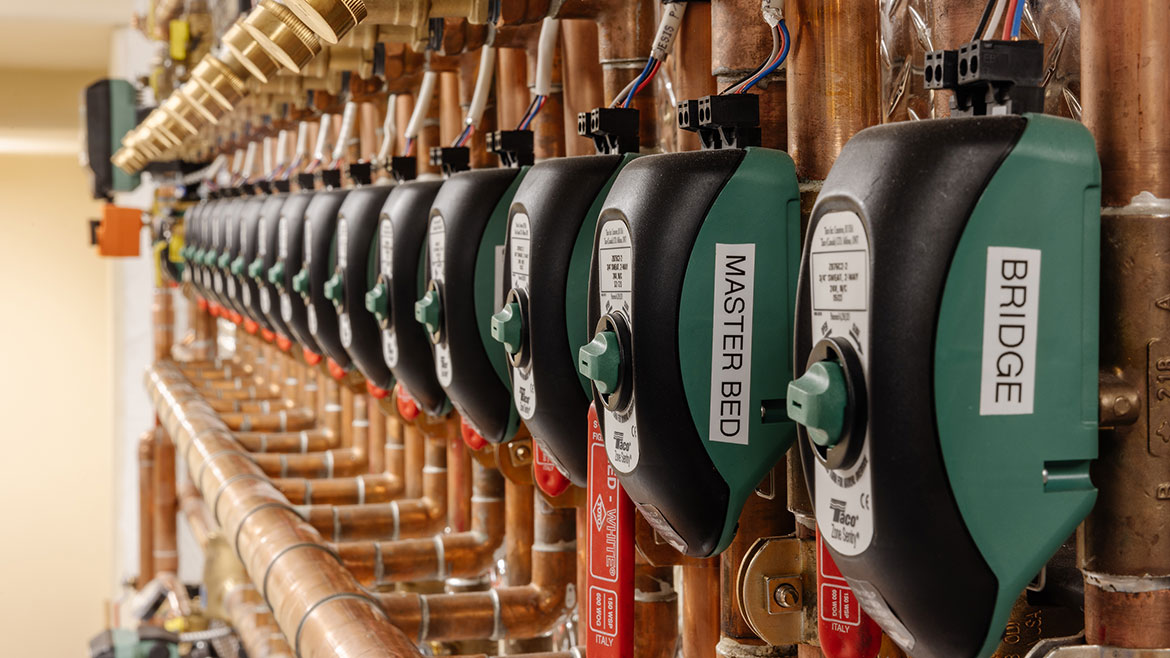
Brandon Content prefers to zone systems with Taco Zone Sentry zone valves instead of pumps, because they keep the cost down, look cleaner and require less power.
Content visited the site, met with the newly hired caretaker and designed four independent mechanical rooms.
“The timeline was the big challenge on this project,” Content explains. “Christmas is a big deal in this family. About 20 people were arriving in mid-December, and everything had to be perfect. Understandably, the caretaker was concerned about the completion date, considering that we started in September.”
Each mechanical room was completely re-piped and re-wired. That fall, PSI technicians installed 13 boilers, removed drywall to route new supply and return lines and installed two titanium heat exchangers, one for the pool and one for the outdoor stream.
“The stream isn’t heated to keep it from freezing,” Content says. “It’s heated to ensure that the surface of the water steams in the winter. It’s an aesthetic element that the owners insisted on having. There’s no standard heat load calculation for making surface water steam at a specific outdoor ambient temperature, so Brandon Pease and I sat down and figured it out. He’s extremely helpful in those situations. If I need him, he makes himself available immediately.”
Inside, the mechanical rooms have the same look and feel that all PSI boiler rooms have. The floors are epoxy coated, the space is well lit, all wiring is concealed behind diamond plate aluminum, the boilers are vented with Centrotherm InnoFlue and large, detailed diagrams of the entire system are mounted permanently on the wall like pieces of fine art.
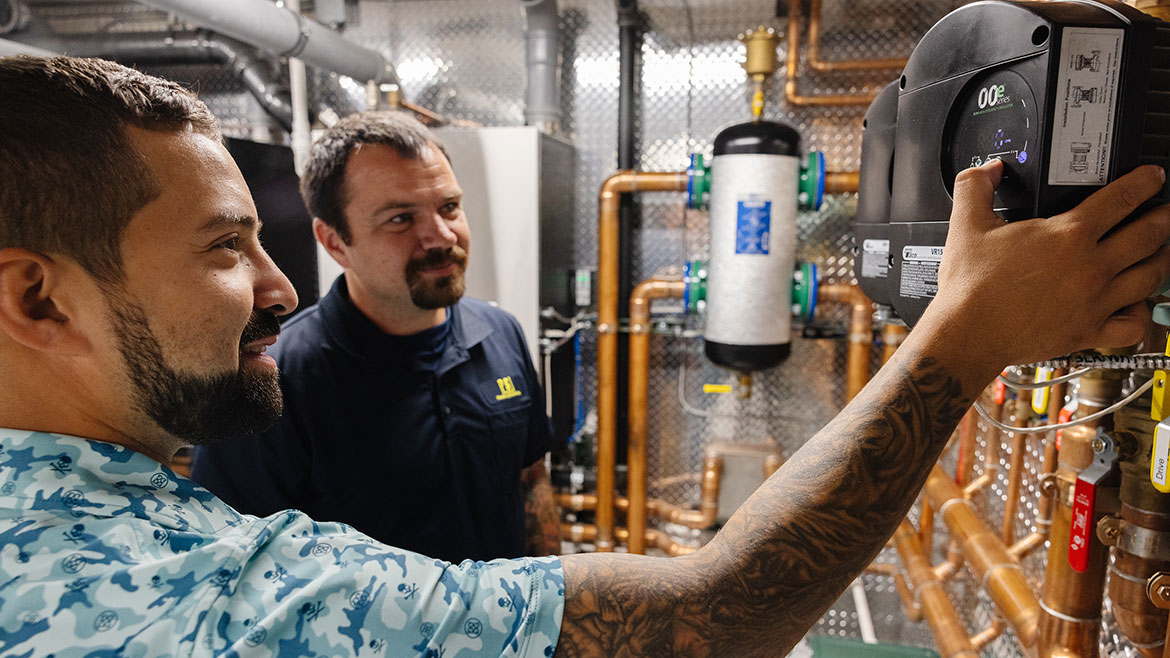
Brandon Content explains the snow-melt system’s operation to the property caretaker.
“As big as these systems are, they’re simple,” Content says. “I want a service tech who’s never been here before to look at the diagram and immediately figure out what they’re looking at. If there’s ever an issue, I want the ability to walk the caretaker or owner through basic troubleshooting over the phone. Keep it simple and make it pretty, that’s the goal.”
Work at the big home concluded on Dec. 10. Content was onsite observing the system until noon on Dec. 11. The family arrived at 1 p.m.
A true visionary
With its steady, sustainable growth, Harper has known for a few years that PSI needed a new facility. In May 2023, the company moved into its new shop: a 21,000 square-foot, two-story facility with 7,000 feet of warehouse space, offices, conference rooms, a spacious lobby, training center, gym and an apartment for remote employees to use when they visit HQ.
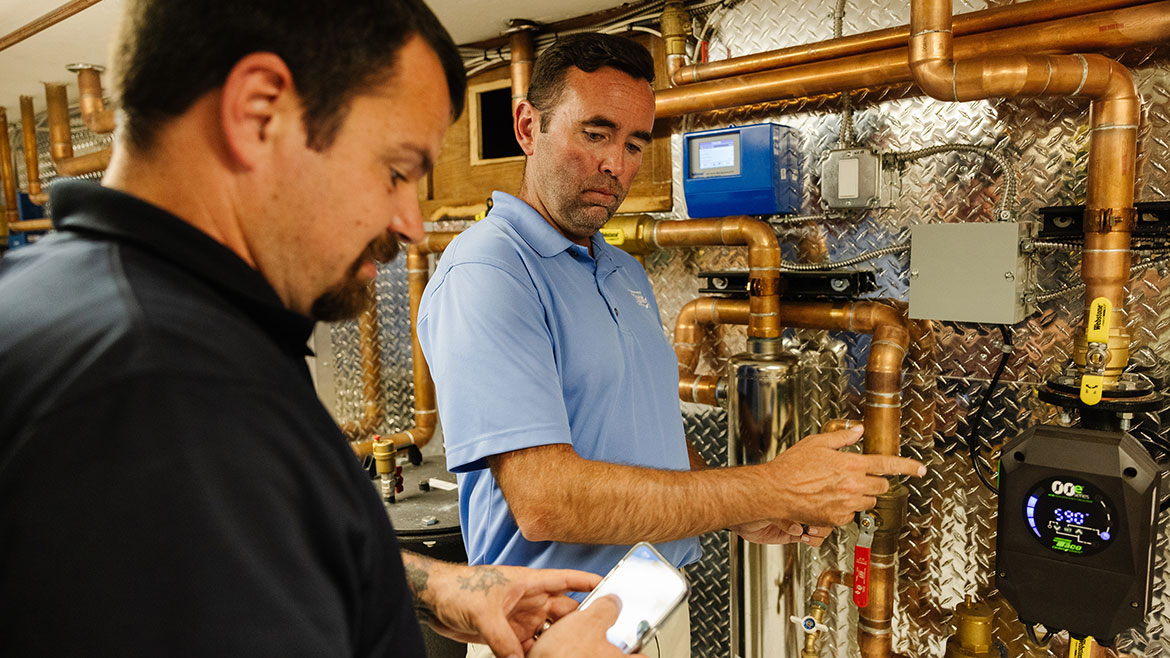
Brandon Content and Brandon Pease use Taco's exclusive Taco Tags to access pump data.
“We’re better organized now,” Harper says. “Workflow has greatly improved. The warehouse space lets us expand and avoid material shortage issues. We’ve integrated Service Titan dispatching and CRM software, and weekly team meetings have improved communication across the board.”
In true PSI form, the robust mechanical system for the shop is on full display. The 14,000 square-foot main floor is radiantly heated, and 2,000 square feet of snow-melt is installed, split between delivery ramps and a filling station for jetter trucks.
“What I’m most excited about now is to finish building out our upstairs training facility and to invest heavily in the local community to establish the next generation of technicians,” Harper says. “In the near future, there’s sure to be a vacuum in that space, both locally and nationally. PSI’s going to solve that problem in the Vail Valley.”
Harper has taken an aggressive stance against the skilled labor deficit, using the reputation of his company and the allure of Colorado as an incentive to attract young talent.
“I’ve had great success recruiting from the Northeast,” he explains. “There’s a lot of hydronic experience in those states. Minnesota’s the same. I’ve even recruited from Arkansas and California. In 2007, when the auto industry died in Detroit, I hired a few great people from Michigan.”
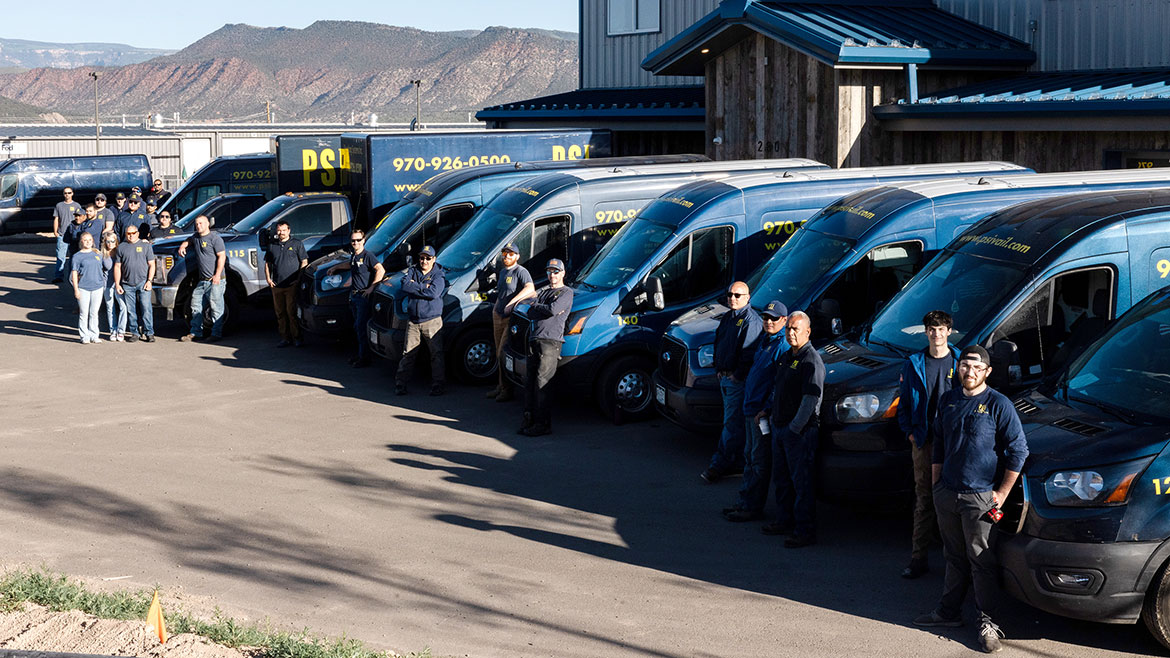
The PSI team is 70 people strong, with locations in Vail and Silverthorne, Colorado.
Not only is Vail an outdoor Mecca, but potential hires witness the level of work that PSI conducts. Many find that they want to be a part of the movement.
“We’re leveraging Nexstar Network to develop an employee training program to include both technical and soft skills,” Harper continues. “I’d like to generate so many top-tier employees that I have no choice but to open more PSI branches in Colorado and maybe even around the country. If a company can’t succeed at hiring, training and retaining high-quality people, its days are numbered.
“My ultimate goal is to have an army of technicians that we’ve trained in our facility, all capable of doing the job the right way,” Harper adds. “Hiring the right people, training them proactively and acknowledging their fine work, that’s what provides value to the customer.”
Looking for a reprint of this article?
From high-res PDFs to custom plaques, order your copy today!







